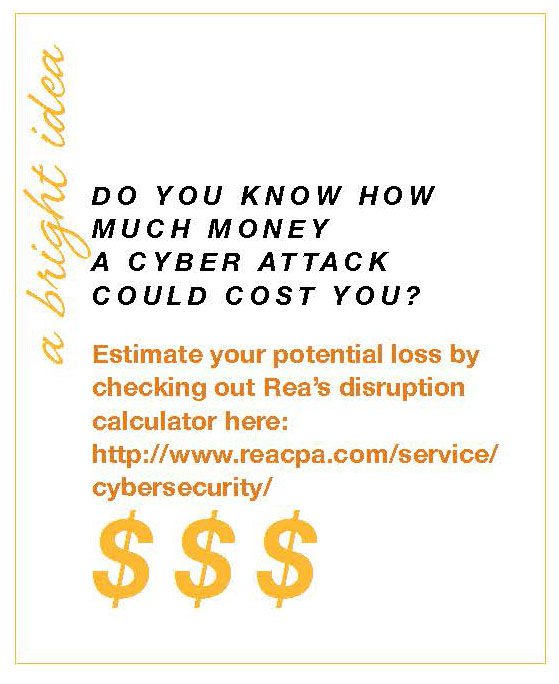
Statistics tell a story. And the latest story is that cybercriminals are aggressively hitting small- to mid-sized businesses.
Why You May Think You’re Not At Risk
Every small business owner has an opinion regarding cybersecurity. Some may simply be unaware of the depth of risks to their business while others may believe they have no risk at all. Aside from the fact that so many small businesses are generally not well protected, a small business owner might underestimate their digital value and falsely conclude, “What is there to steal?”
In today’s economy, information is as valuable as money. Cybercriminals know you have it and they want it for themselves. Like many businesses, you probably maintain a database of customer information. This database might include their contact information, payment methods, and purchase history. This is enough to make a cyber criminal’s mouth water. You’d be surprised what a bad actor can (and will) do with all of that juicy information.
As the publication Small Business Trends reports, 43 percent of cyber attacks target small businesses, and only 14 percent of small businesses rate their ability to mitigate such attacks as “highly effective.” These jarring statistics should cause you to pause if you’re a “mom and pop” operation. Don’t think for a second that just because you’re a small operation, you’re not a target for cyber criminals. The objective of cyber criminals is to get money quickly and easily.
Your Cybersecurity Journey Starts Now
The purpose of this article is not to scare you. Instead of fearing the worst, consider how you can become more proactive when it comes to protecting your business and the information you collect.
A proactive cybersecurity strategy is your best bet at mitigating your cyber risks. The first step in your strategy is to undergo a security risk assessment and monetarily quantify your current IT risk. A security risk assessment will help you determine – beyond hardware and software tools – what you can stand to lose financially if you were to become a victim of cybercrime. Next, start weaving cybersecurity best practices into the fabric of your business. Read on for additional tips and insight.
Go Beyond Just ‘Strengthening’ Your Cybersecurity Efforts
Citing a 2018 report by the insurance provider, Hiscox, Nerd Wallet states only 52 percent of small businesses have a cybersecurity strategy in place. And this is even though the threat of a cyber-attack continues to grow.
One way to go beyond simply assessing and strengthening your business’s cybersecurity efforts is to integrate a cybersecurity maturity model into your practices. This model can help ensure that you have taken all necessary precautions to mitigate a cyber attack.
The U.S. Department of Defense (DoD) has developed the Cybersecurity Maturity Model Certification (CMMC) as the new standard for cybersecurity controls within the manufacturing and construction industries, as well as local government entities. This certification process provides assurance to the DoD that the company is equipped to protect sensitive unclassified information. Sensitive unclassified information might include data that may be transferred between vendors and partners. Of course, securing this level of certification isn’t easy.
Rea & Associates was named a Registered Provider Organization for CMMC, a distinction that pertains to fewer than 300 organizations. Additionally, several members of Rea’s cyber team are considered Certified Registered Practitioners.
Cybersecurity Maturity As A Part Of Your Business Culture
One telling sign that your company possesses cybersecurity maturity is whether cybersecurity practices have permeated every aspect of your business culture. If you understand and apply cybersecurity practices and set the correct “tone at the top” when it comes to respecting cybersecurity risks, you’re on your way to attaining cybersecurity maturity.
The next step is to ensure all of your employees are aware of proper cybersecurity practices. This can be done by training employees as soon as they are hired with additional training annually. Don’t make the mistake of thinking a specific subset of employees, such as those who don’t work with computers daily basis, may not need cybersecurity training. These individuals are also at risk of falling for social engineering tactics that are often used by clever hackers who are known to show up at your physical location.
Listen to episode 292, “Problem Hunting Vs. Threat Hunting,” on unsuitable on Rea Radio, Rea & Associates’ award-winning weekly business podcast.
The Cost Of Not Taking Cyber Threats Seriously
Yes, cybersecurity and data protection efforts cost money. To determine if the investment is worth it for your business, simply weigh the upfront costs against the potential costs of a security breach while remembering that costs extend far beyond the initial breach.
- Consider the following financial repercussions, or loss exposure, of a possible breach:
- Customer notification costs
- Incident response
- Forensic investigations
- Lost business revenue
- Industry fines and penalties
- Lawsuits
- Upgrade or replacement of systems
In addition to the financial consequences outlined above, the costs to your reputation may be the most devastating and harder to quantify. When customers patronize a business or contract for your services, they trust that their information will be kept safe and secure. Businesses that are victims of a data breach risk damaging that trust. That alone could be the end of any business trying to make a name in this world.
Next Steps
Small business owners owe it to themselves, their employees, and their customers to recognize the importance of cybersecurity and data protection while taking proactive steps to protect their organizations from cybercrime. Rea & Associates is committed to providing you with tools, resources, and solutions designed to keep businesses safe amid digital uncertainty. Contact me today to learn more.
By Travis Strong, CISA (Wooster, OH)
Learn more about protecting your business from cyber criminals. Check out these resources:
[PODCAST] Is Your Business Putting National Security At Risk?
[PODCAST] MSP Vs. MSSP: What’s The Difference?
[WEBINAR] Are You Managing Your Cybersecurity Risk Exposure?

